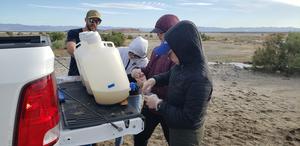Katherine Mackey and the Salton Sea surprise

Mackey’s team prepares to sample water from the Salton Sea, to see what life might live there.
Katherine Mackey studies the boundary between the living and the nonliving worlds. She wants to know how those two worlds define one other, as things like aquatic microorganisms can alter the chemistry of the water they live in, and the chemistry of the water can then affect the kinds of organisms able to live there.
“It’s this really beautiful and delicate and refined feedback that exists in nature,” says Mackey, who’s UCI’s Clare Boothe Luce Assistant Professor of Earth System Science. “That’s really what drives my passion in the work.”
In 2018 and 2019, Mackey and her lab journeyed to the Salton Sea near Palm Springs, California in search of the living-nonliving boundary. The Salton Sea formed when the Colorado River overflowed its banks in 1905, and people then stocked the sea with fish hoping to turn the area into a tourist destination. But years of drought saw the sea become saltier and saltier. “It’s been drying now since the 50s,” Mackey says. The salinity is about twice that of the oceans, and those salinity levels reached a tipping point and all of the fish in the Salton Sea died. “It’s really an ecosystem on the verge of collapse,” Mackey says.
Water levels are now so low that there are swaths of dry mudflats at the edge of the sea. The ground at those edges is soft, “almost like quicksand,” says Mackey. “My student drove too close to the edge and the truck started to sink.”
The student tried to dislodge the truck — but it sank all the way to its axles. The team left the truck behind, and asked the rangers at the Sonny Bono Nature Preserve, which was where they were doing their fieldwork, to help them. The rangers came with a giant blue tractor the next morning and pulled the truck out of the edge of the sea.
The lab turned back to their work. They sampled the Salton Sea water, and they found something no one thought was in the Salton Sea anymore: life. “What we’ve found is a remarkably diverse community of microorganisms,” Mackey says. They discovered freshwater organisms that floated into the sea via waters originally from the Colorado River, and they found seawater organisms, too.
Mackey’s team, it seems, weren’t the only ones contending with — and overcoming — the harsh conditions. “To see such diversity in such an extreme environment is a testament to nature’s resilience and beauty,” Mackey says.
